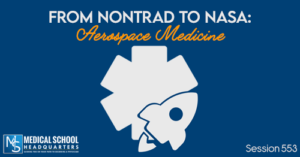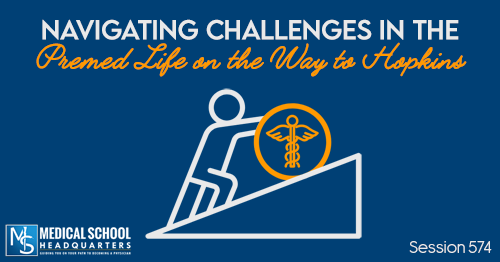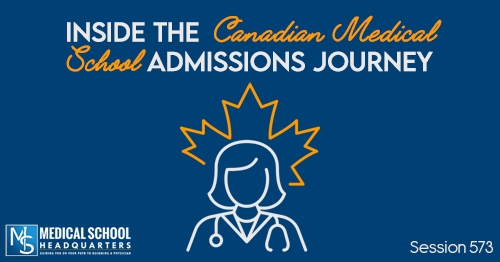Apple Podcasts | Google Podcasts
Session 553
The incredible Dr. Natacha Chough breaks down her journey of how she went from a nontrad applicant to a specialist in Aerospace Medicine.
For more podcast resources to help you with your medical school journey and beyond, check out Meded Media.
Listen to this podcast episode with the player above, or keep reading for the highlights and takeaway points.
Natacha’s Dream of Becoming a Doctor
Natacha always had a dream of working for NASA ever since she was a little kid. She was fascinated by space and astronauts. In college, she majored in biology but realized she didn’t want to pursue a career in research. She learned about the field of aerospace medicine, which allowed her to work for NASA as a physician.
Natasha had to go through medical school and residency training before she could become an aerospace medicine doctor at NASA. It took her a few tries to get into medical school but she gained valuable experience working for NASA as an intern and also joining the Peace Corps, which helped strengthen her application. Now she gets to help astronauts prepare for and recover from space missions, while still being involved with the exciting work of NASA.
The Role and Responsibilities of an Aerospace Medicine Physician
There are a few different pathways one can take to become an aerospace medicine physician:
– On the civilian/non-military side, most programs require completing a primary residency in another specialty like emergency medicine, internal medicine, etc. before doing a 2-3 year aerospace medicine fellowship. This helps build a strong clinical foundation.
– The military offers the option to go straight into a 3 year aerospace medicine residency without a prior specialty. This is tailored to the needs of the Department of Defense.
The Role of a Flight Surgeon in Aerospace Medicine
As a flight surgeon practicing aerospace medicine, Natacha explained that their role is different than what the title may imply. The term “flight surgeon” originated from early military medicine terminology and does not involve performing surgery on planes or in space. Instead, flight surgeons play a vital role in providing primary care and ensuring the ongoing health and fitness of pilots and astronauts.
Primary Care and Health Certification
Flight surgeons are responsible for conducting medical evaluations, providing necessary treatments, and certifying patients’ ability to carry out their duties. They carefully consider how any underlying medical conditions may impact performance and safety. This is particularly during emergency situations like engine failures where pilots need to respond promptly.
Flight surgeons also engage in pre-flight training for astronauts, monitoring their health during missions from mission control, and overseeing their rehabilitation after returning to Earth.
Risk Assessment and Review Boards
In addition to their primary care responsibilities, flight surgeons present medical cases to review boards. They utilize their clinical knowledge and judgment to assess whether certain medical conditions pose too much risk for spaceflight.
While emergency response situations make up about 10% of their work, the majority of a flight surgeon’s role involves longitudinal primary care of crews and certification processes.
Exploring Specializations in Medical School
“The whole point of med school is to figure out what you want to specialize in.”
When embarking on the journey of medical school, the main objective is to determine which specialization to pursue. It’s the moment of deciding what kind of physician one aspires to become.
For some, like Natacha, their passion for aerospace medicine was already present before entering med school. Natacha shares how she was aware of the opportunities, such as the HPSP scholarship and military-related scholarships, that could lead to a career in aerospace medicine.
Initially, she considered the military route. Being a non-traditional student who had taken a break, worked at NASA, and joined the Peace Corps, Natacha realized that the military path might create more distance between them and their ultimate goal of working at NASA.
A Non-Traditional Path to Aerospace Medicine
Discussing their own non-traditional path, Natacha explains why they didn’t choose a direct route from undergrad to med school to reach NASA faster. Despite their desire to work at NASA, they pursued a different avenue initially, working at NASA in various capacities without being a physician.
Natacha’s goal was to gain diverse experiences and contribute to the field of aerospace in a different way. However, as time went on, it became apparent that becoming a physician in the field of aerospace medicine was the ultimate goal, allowing Natacha to combine their passion for medicine with their love for space exploration.
Keeping an Open Mind in Aerospace
Natacha emphasizes the importance of staying open-minded when it comes to exploring opportunities in the aerospace industry. While military scholarships and careers can be a great fit for some, it may not align with everyone’s individual aspirations.
Natacha’s personal journey taught her the value of assessing one’s own goals and motivations, and making choices that align with those aspirations. That being said, many of her colleagues have had positive experiences with military scholarships and careers, highlighting the diverse paths that lead to a fulfilling career in aerospace medicine.
Natacha’s Journey to Medical School: Overcoming Challenges and Gaining Perspective
Natacha candidly shares her experience of not getting into medical school on her first attempt, a challenge that she believes is often overlooked or stigmatized. She reflects on the feelings of shame and embarrassment that can accompany multiple attempts at gaining admission.
Natacha acknowledges that her initial MCAT scores were not up to par. But with the benefit of hindsight, she recognizes that her maturity level at that time may have also played a significant role.
The Transformative Power of the Peace Corps
Undeterred by their initial setback, Natacha decided to embark on a life-changing journey with the Peace Corps. This experience provided her with a newfound perspective and pushed her out of their comfort zone.
Despite having a multicultural background, the Peace Corps exposed Natacha to entirely new environments. She had to adapt to different rules and live without the privileges and luxuries she was accustomed to in the United States. This immersion in a foreign country shaped Natacha in profound ways and bolstered her confidence.
Growth, Confidence, and Maturation
With a renewed sense of self and a deeper understanding of patient situations gained through community and public health work during her time in the Peace Corps, Natacha applied to medical school for the third time. This time, sheapproached the process with more confidence in their abilities and a greater level of maturity.
Natasha believes it was a combination of improved MCAT scores and increased confidence and maturity from her experiences that ultimately led to her acceptance into medical school on the third application. Natacha’s commitment to personal growth is evident as she acknowledges that even in her twenties, there is much to learn and room to develop as an individual.
Navigating Primary Specialties in Aerospace Medicine: Managing Risk in an Abnormal Environment
“Normal medicine is abnormal physiology in a normal environment. Aerospace medicine is normal physiology and an abnormal environment.”
In the realm of aerospace medicine, Natacha explains the significance of selecting a primary specialty as the first step in their training pathway. This is particularly crucial in civilian settings, where options include working at NASA or within commercial space companies.
Regardless of the chosen specialty, a strong clinical foundation is essential for success in the field.
Aerospace medicine assumes that practitioners possess a solid understanding of terrestrial medicine, which serves as the basis for applying medical principles in abnormal environments.
Normal Physiology in an Abnormal Environment
Drawing a contrast between traditional medicine and aerospace medicine, Natacha highlights that terrestrial medicine deals with abnormal physiology in a normal environment, while aerospace medicine involves managing normal physiology in an abnormal environment. This distinction becomes even more complex when considering commercial spaceflight, where individuals with various medical conditions, such as high cholesterol or prosthetic limbs, seek certification to fly.
As a result, the process of medically certifying individuals for spaceflight becomes challenging, requiring careful consideration of cumulative risks associated with each condition.
Navigating Certification Challenges and Managing Risk
At the University of Texas Medical Branch (UTMB), where Natacha completed her aerospace medicine residency, the focus is on preparing residents for the complexities of medical certification in aerospace settings.
Residents are given opportunities to practice presenting certification cases before a board. It involves incorporating real-life scenarios that require informed decision-making in the absence of comprehensive data. Lessons from organizations like the Air Force, Navy, and Federal Aviation Administration (FAA) help inform the risk management strategies employed in aerospace medicine.
The field of aerospace medicine continually evolves, with NASA and commercial space companies constantly learning and adapting. Managing risk in this unique realm necessitates careful assessment, collaboration, and a reliance on both established and emerging medical knowledge.
Through dedicated training programs and ongoing research, physicians in aerospace medicine strive to ensure the safety and well-being of individuals embarking on extraordinary journeys beyond Earth’s atmosphere.
Following Your Gut: Natacha’s Path to Emergency Medicine in Aerospace
Natacha’s journey led them to specialize in emergency medicine, a field they fell in love with. Reflecting on their experiences, Natacha advises students to trust their instincts during ward rotations in their third and fourth years of medical school.
Despite initial fears of surgery, her first rotation in transplant surgery shattered stereotypes and left a lasting impression. This encounter ultimately influenced Natacha’s decision to pursue emergency medicine. She emphasizes the importance of staying open-minded and recognizing when a particular specialty may not align with one’s true interests.
The Appeal of Emergency Medicine in Aerospace
For Natacha, emergency medicine emerged as the perfect fit. She appreciated the dynamic nature of the specialty, with its focus on procedures and immediate patient feedback. The role of an emergency physician as a jack of all trades resonated with Natacha, as it allowed her to have a broad knowledge base.
In the context of aerospace medicine, this versatility proves invaluable during in-flight emergencies when the expertise of various medical professionals may be required. However, Natacha also emphasizes that while emergency medicine is a vital aspect of their work as an aerospace physician, it constitutes only a fraction of her daily responsibilities.
Aerospace medicine encompasses a range of duties, including launch and landing preparedness, and disaster management response. It also involves presenting medical cases to air medical boards, which often require a deeper understanding of internal medicine and physiology. Natacha highlights that aerospace medicine offers pathways for professionals from various specialties, and it is not limited solely to emergency medicine.
The Military Route to Aerospace Medicine
There is a military route to becoming an aerospace medicine physician as an alternative to the civilian path. You can go straight into a 3-year aerospace medicine residency (called RAMS – Residency in Aerospace Medicine) without first completing a primary specialty residency, as is typically required on the civilian side. This option is available because the structure of the military training pathway is tailored to meet the needs of the Department of Defense.
Completing the full aerospace medicine residency trains you to the level of being board certified in the specialty. This means you’re ready to practice military aerospace medicine. For those interested in a career serving in the military medical corps, this provides a direct path to working in the aerospace medicine field as a uniformed officer from the start of residency training.
The Role of a Flight Surgeon: Beyond the Misconceptions
Flight surgeons play a crucial role in ensuring the health and well-being of pilots and astronauts, but their responsibilities extend far beyond what the name suggests. Let’s delve into Natacha’s experience as a flight surgeon and explore the reality of their day-to-day work.
Contrary to popular belief, the term “flight surgeon” does not imply flying in space or performing surgery. It harkens back to the historical use of the term “surgeon” as the primary medical professional on the battlefield. In the context of aviation, a flight surgeon serves as the primary care physician for those who make flying their career. Natacha emphasizes that their role involves providing longitudinal primary care for pilots and astronauts.
“Flight surgeon does not mean you fly in space, nor does it mean that you perform surgery on the ground or in space.”
Working at NASA, Natacha’s day-to-day routine includes navigating bureaucratic processes and attending numerous meetings, as is common in any organizational setting. However, the unique aspect of their job lies in being associated with a space station. Although they do not personally fly to the space station, their patients, the astronauts, do.
Natacha’s primary responsibility is to optimize their health before their journey into space. They provide medical training to equip astronauts with the necessary skills to care for themselves during their missions since having a doctor on the space station is not a requirement. This training encompasses basic medical procedures such as suturing and phlebotomy for research purposes, bringing astronauts to an equivalent level of an EMT.
From the ground, Natacha guides and directs their medical activities. This telemedicine approach was embraced by NASA long before it became widespread, even before the COVID-19 pandemic. The field of aerospace medicine, including space medicine, has been evolving since the 1960s, highlighting NASA’s early adoption of telemedicine practices.
Potential Downsides of a Career in Aerospace Medicine
According to Natacha, one potential downside of pursuing a career in aerospace medicine is that it falls under the umbrella of preventive medicine. This means the pay may not be as high compared to other medical specialties.
However, there are also benefits to working for an organization like NASA or the government. The risk of malpractice lawsuits is much lower since physicians are covered as public servants rather than in private practice. Commercial space companies are still figuring out how to legally protect doctors they hire. So the financial and legal aspects of working in different sectors of aerospace medicine need to be carefully considered.
Links:
Aerospace Medicine Student and Resident Organization












